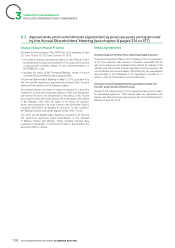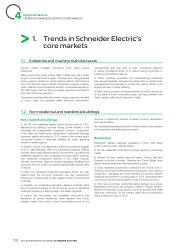APC 2015 Annual Report Download - page 172
Download and view the complete annual report
Please find page 172 of the 2015 APC annual report below. You can navigate through the pages in the report by either clicking on the pages listed below, or by using the keyword search tool below to find specific information within the annual report.
2015 REGISTRATION DOCUMENT SCHNEIDER ELECTRIC170
CORPORATE GOVERNANCE
3INTERNAL CONTROL AND RISK MANAGEMENT
International Financial Reporting Standards
(IFRS)
The consolidated fi nancial statements for all fi scal years
commencing on and after January1, 2005 have been prepared in
accordance with International Financial Reporting Standards (IFRS),
in compliance with European Union regulation no.1606/2002.
The Group applies IFRSstandards as adopted by the European
Union as of December31, 2015.
The Group’s accounting principles refl ect the underlying assumptions
and qualitative characteristics identifi ed in the IFRS accounting
framework: accrual accounting, business continuity, true and
fair view, rule of substance over form, neutrality, completeness,
comparability, relevance and intelligibility.
The Group statutory and management accounting standards
manual explains how IFRSprinciples are applied within the Group,
taking into account the specifi c characteristics of the Group’s
activities.
The application of Group accounting principles and methods is
mandatory for all Group units, for management reporting and
statutory consolidation.
The Group statutory and management accounting standards
manual and the IFRSprinciples are available on the Intranet.
Commitment limits and authorizations
Under current management practice, the Group has set
commitment limits for Senior Management of Group companies
and delegation and sub-delegation of powers within each company
that makes up the Group.
As a result, product or service purchase and sale contracts may
only be signed by, or with the authorization of, operations managers
who have ad hoc authorizations granted by their managers.
Within this framework, business segment executives have the
power to authorize the signature of product or service, purchase
or sale contracts covering up to EUR10 million. They may also
delegate to their employees powers to authorize smaller amounts
as they consider appropriate.
In addition, all transactions which by their size or nature could
affect the Group’s fundamental interests, must be authorized
in advance by the board of directors: decisions relating to the
acquisition or disposal of holdings or assets for amounts greater
than EURO250 million , to strategic partnerships, and to off-balance
sheet commitments.
Statutory and management reporting
principles
An integrated reporting and consolidation system applicable to all
Group companies and their management units has been in place
since January 1, 2006. Statutory and management reporting
principles and support tools are available on the Group Intranet.
The subsidiaries record their transactions in accordance with Group
standards. Data are then adjusted, where necessary, to produce
the local statutory and tax accounts.
The reporting system includes consistency controls, a comparison
of the opening and closing balance sheets and items required to
analyze management results.
Key Internal Controls
A list of Key Internal Controls was drawn up in2008 and is reviewed
annually. They cover:
•the Control Environment (including the Responsibility and Ethics
program, chart of authority, segregation of duties, business
continuity plan, retention of records and business agents);
•operating processes (Purchases, Sales, Logistics,etc.);
•a ccounting and fi nancial related cycles;
•Human Resources and Information Systems cycles.
The Key Internal Controls are available to all units on the Group
employee portal and shared depository, along with appendices
with more detailed information, links to policy descriptions, an
explanation of the risks covered by each Key Internal Control and a
self-assessment guide.
For each cycle, the Key Internal Controls cover compliance, reliability,
risk prevention and management and process performance. The
operating units fi ll out self-assessment questionnaires concerning
the Key Internal Controls.
For new acquisitions, the entities may continue with their existing
controls in transition before deploying the Key Internal Controls.
9.4 Risk identification and management
General risks at the Group level
The Internal Audit Department uses interviews to update the list
of general risks at the Group level each year. In2015, 70 of the
Group’s top managers were interviewed. In 2015 individualised risk
matrices by Operation or by Business have been created.
The risks identifi ed through these interviews are ranked by a risk
score (comprising impact and likelihood of occurrence) and level
of mitigation.
Risk factors related to the company’s business, as well as
procedures for managing and reducing those risks, are described
in «Risk Factors. » These procedures are an integral part of the
internal control system.
The risk matrix and the analysis of changes from one year to the
next contribute to the development of an internal audit plan for the
following year. 70% of the risks categories identifi ed in the Group’s
risk matrix are audited by the Internal Audit Department over a
period of three years to assess action plans for managing and
reducing these risks.
























